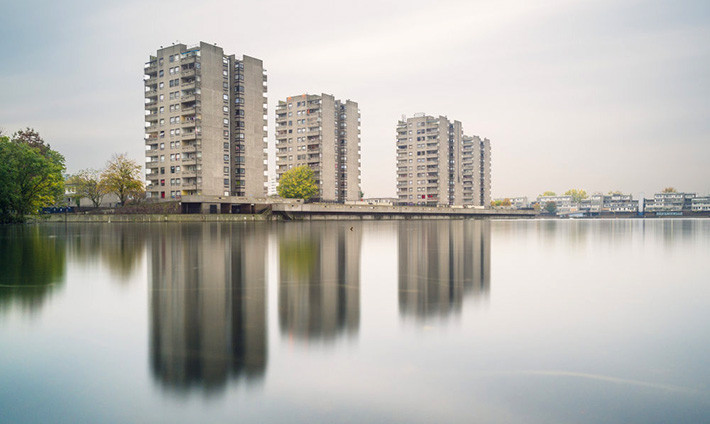Thamesmead
Heralded by the Greater London Council (GLC) as a “town for the 21st century”, the Woolwich-Erith Riverside Project was only christened Thamesmead in 1967 following a Name Our New Town competition with a £20 prize. To be built on marshland and part of the Woolwich Arsenal site, it was intended to help ease the capital’s post-war housing shortage and to be a town of 60,000 people exploiting a riverside position with sufficient local employment, amenities and transport infrastructure.
The 1967 master plan envisaged a combination of long spine blocks and high- rise point blocks but Thamesmead’s design and landscape was influenced by the site. Pollution from local heavy industry prohibited building above 200ft dictating squat 13-storey point blocks rather than the few intended tall, slim blocks. In 1953 the site was flooded by the North Sea inundation, thus for flood protection all habitable accommodation had to be on the first floor with garages and service areas below. The houses were innovatively linked by raised walkways also serving to separate pedestrians from road traffic. To assist in controlling water levels a series of balancing lakes and canals would drain run-off water into the Thames at low tide.
Such was the initial international attention given to Thamesmead’s architecture that the early residents found the great number of visitors highly intrusive. However, media focus on the GLC’s flagship project soon switched to its failings, in particular the urban alienation of disillusioned residents. Today its reputation is synonymous with the film A Clockwork Orange but the problems predated the film’s 1971 release. The much vaunted walkways had the unintended consequence of dark no-go areas below, facilities took too long to develop, transport links were poor and contaminated land and ground conditions led to expensive construction and delays.
Despite being the culmination of the GLC’s housing works, ultimately only stages 1 and 2 were completed in a form resembling the master plan which largely remained an unrealised vision. Mostly forgotten today, much of Thamesmead, ironically, now comprises suburban housing and although there is a programme of regeneration for stages 1 and 2 this is proceeding slowly and has resulted in the demolition of the futuristic Lakeside Health Centre (Derek Stow & Partners, 1972).
50 years on from the initial construction phase this gallery is illustrated by historic photographs from the RIBA Robert Elwall Photographs Collection and the work of contemporary photographers Christopher Hope-Fitch and Joanne Underhill. To see additional images of Thamesmead click here. All of the images are available to download, purchase or license.
Visit the photographic exhibition Thamesmead: A Town for the 21st Century at the RIBA which runs until 16 May 2019.
